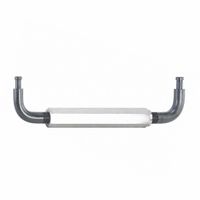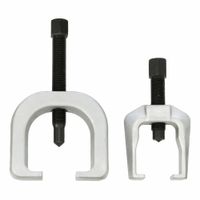Call +(254) 703 030 000 / 751 483 999 / 721 704 777
- Home
- Fleet Vehicle Maintenance
- Vehicle Tools
- Steering Suspension Tools
Steering & Suspension Tools
Steering and suspension maintenance is done to ensure a vehicle has proper control on the road. Kits provide all the tools needed to pull out the old wheel system and install a new one. Suspension level kits contain the tools needed to provide vehicles with increased ground clearance while leveling .....Read More
Frequently Asked Questions
What are the signs of a failing steering and suspension system?
Signs of a failing steering and suspension system include:
1. **Unusual Noises**: Clunking, knocking, or squeaking sounds when driving over bumps or turning can indicate worn-out suspension components like struts, shocks, or bushings.
2. **Poor Handling**: Difficulty in steering, such as a loose or stiff steering wheel, can suggest issues with the steering system, including problems with the power steering pump or fluid.
3. **Vibrations**: Excessive vibrations felt through the steering wheel, especially at higher speeds, may be due to unbalanced wheels, worn-out suspension parts, or misaligned wheels.
4. **Uneven Tire Wear**: If tires show uneven wear patterns, it could be a sign of misalignment, worn suspension components, or improper tire inflation.
5. **Vehicle Pulling**: The car pulling to one side while driving or braking can indicate alignment issues or problems with the steering system.
6. **Bouncing**: Excessive bouncing after hitting a bump suggests worn-out shock absorbers or struts, which are crucial for absorbing road impacts.
7. **Nose Diving or Squatting**: The vehicle nose diving when braking or squatting when accelerating can indicate worn shocks or struts.
8. **Fluid Leaks**: Leaks under the vehicle, particularly around the wheels or steering components, may indicate leaking shock absorbers or power steering fluid.
9. **Steering Wheel Play**: Excessive play or looseness in the steering wheel can be a sign of worn steering components or a failing steering rack.
10. **Dashboard Warning Lights**: Illuminated warning lights related to the suspension or steering system, such as the ABS or traction control light, can indicate underlying issues.
Regular maintenance and inspections can help identify and address these issues before they lead to more severe problems.
How often should steering and suspension maintenance be performed?
Steering and suspension maintenance should generally be performed every 12,000 to 15,000 miles or at least once a year, whichever comes first. However, the frequency can vary based on driving conditions, vehicle type, and manufacturer recommendations. For vehicles frequently driven on rough roads, off-road, or in areas with harsh weather conditions, more frequent inspections may be necessary. Regular maintenance includes checking for wear and tear on components such as shocks, struts, tie rods, and ball joints, as well as ensuring proper alignment and balance. It's also important to inspect for any unusual noises, vibrations, or handling issues, which can indicate problems with the steering or suspension systems. Always refer to the vehicle's owner manual for specific guidelines and consult a professional mechanic for personalized advice.
What tools are included in a steering and suspension kit?
A steering and suspension kit typically includes a variety of components designed to maintain or improve the handling, stability, and comfort of a vehicle. Key components often found in such kits are:
1. **Control Arms**: These connect the vehicle's suspension to the frame and allow for controlled movement of the wheels.
2. **Ball Joints**: These act as pivot points between the wheels and suspension, allowing for smooth steering and suspension movement.
3. **Tie Rod Ends**: These connect the steering rack to the steering knuckle, transmitting force from the steering wheel to the wheels.
4. **Sway Bar Links**: These connect the sway bar to the suspension, helping to reduce body roll during cornering.
5. **Bushings**: These are used in various parts of the suspension to reduce friction and absorb road shocks.
6. **Struts and Shocks**: These dampen the impact of road irregularities, providing a smoother ride and better handling.
7. **Coil Springs**: These support the vehicle's weight and absorb shocks from the road.
8. **Steering Rack or Gearbox**: This component translates the rotational movement of the steering wheel into linear movement to turn the wheels.
9. **Idler and Pitman Arms**: These are part of the steering linkage in some vehicles, helping to transfer motion from the steering box to the wheels.
10. **Wheel Bearings**: These allow the wheels to rotate smoothly with minimal friction.
11. **Alignment Components**: Such as camber bolts or caster shims, which help in adjusting the wheel alignment for optimal handling.
These components work together to ensure the vehicle maintains proper alignment, handling, and comfort, while also ensuring safety and performance.
How do suspension leveling kits work?
Suspension leveling kits are designed to adjust the height of a vehicle's suspension, primarily to level the front and rear ends. They are commonly used in trucks and SUVs to counteract the factory rake, where the rear is higher than the front to accommodate heavy loads. Here's how they work:
1. **Components**: Leveling kits typically include spacers, torsion keys, or coil spring adjusters. Spacers are used for coil spring suspensions, torsion keys for torsion bar suspensions, and strut extensions for vehicles with strut-type suspensions.
2. **Installation**: The kit is installed on the front suspension to raise it to the same height as the rear. For coil spring suspensions, spacers are placed above or below the coil springs. In torsion bar systems, new torsion keys adjust the bar's tension, raising the vehicle's front. Strut extensions are added to the top of the strut assembly.
3. **Functionality**: By raising the front end, leveling kits provide a more balanced stance. This adjustment can improve ground clearance, allowing for larger tires and better off-road capability. It also enhances the vehicle's aesthetics by eliminating the nose-down appearance.
4. **Impact on Ride and Handling**: While leveling kits can improve the look and functionality of a vehicle, they may alter the ride quality. The change in suspension geometry can affect handling, steering, and alignment. It's crucial to have a professional alignment done after installation to ensure proper handling and tire wear.
5. **Considerations**: When choosing a leveling kit, consider the vehicle's make, model, and intended use. Some kits may require additional modifications, such as longer shocks or brake line adjustments, to maintain optimal performance and safety.
In summary, suspension leveling kits are a practical solution for achieving a balanced vehicle stance, enhancing aesthetics, and improving off-road capabilities, though they may require additional adjustments to maintain ride quality and handling.
What is the importance of steering fluid in a vehicle?
Steering fluid, commonly known as power steering fluid, is crucial for the efficient operation of a vehicle's power steering system. It serves several important functions:
1. **Lubrication**: Steering fluid lubricates the moving parts within the power steering system, such as the pump, valves, and pistons. This reduces friction and wear, prolonging the lifespan of these components.
2. **Hydraulic Function**: The fluid acts as a medium to transfer hydraulic pressure from the steering wheel to the wheels. When you turn the steering wheel, the fluid helps amplify the force applied, making it easier to steer the vehicle, especially at low speeds or when the vehicle is stationary.
3. **Heat Dissipation**: As the power steering system operates, it generates heat. The fluid helps dissipate this heat, preventing overheating and potential damage to the system.
4. **Corrosion Prevention**: Steering fluid contains additives that protect the internal components of the power steering system from rust and corrosion, which can be caused by moisture and contaminants.
5. **Seal Conditioning**: The fluid helps maintain the flexibility and integrity of seals within the system, preventing leaks and ensuring consistent performance.
6. **Noise Reduction**: Properly maintained steering fluid can help reduce noise from the power steering pump and other components, contributing to a quieter driving experience.
In summary, steering fluid is essential for ensuring smooth, efficient, and reliable steering performance. Regular maintenance, including checking and replacing the fluid as needed, is vital to prevent steering issues and maintain vehicle safety.
How can I increase the ground clearance of my vehicle?
To increase the ground clearance of your vehicle, consider the following methods:
1. **Suspension Lift Kits**: Install a suspension lift kit to raise the vehicle's suspension system. This involves replacing or modifying components like springs, shocks, and control arms to achieve a higher ride height.
2. **Body Lift Kits**: Use body lift kits to raise the body of the vehicle from the frame. This method involves adding spacers between the body and the frame, providing additional clearance without altering the suspension geometry.
3. **Taller Tires**: Replace your current tires with larger ones. This increases the overall height of the vehicle, thus improving ground clearance. Ensure that the new tires fit within the wheel wells and do not rub against the body or suspension components.
4. **Adjustable Air Suspension**: If your vehicle is equipped with air suspension, adjust the settings to increase the ride height. Some vehicles allow for manual adjustments, while others may require a software update or aftermarket controller.
5. **Coil Spring Spacers**: Install coil spring spacers to increase the height of the vehicle. These spacers are placed on top of the existing coil springs, providing a simple and cost-effective way to gain additional clearance.
6. **Aftermarket Struts/Shocks**: Replace the stock struts or shocks with aftermarket options designed to provide a lift. These components can offer improved performance and increased height.
7. **Torsion Bar Adjustment**: For vehicles with torsion bar suspension, adjust the torsion bars to raise the front end. This method requires careful adjustment to maintain proper alignment and handling.
8. **Professional Installation**: Consider having a professional mechanic or off-road specialist perform the modifications to ensure safety and proper installation.
Always ensure that any modifications comply with local laws and regulations, and consider the impact on vehicle handling, stability, and warranty.
What are the benefits of leveling the front end with the rear?
Leveling the front end with the rear of a vehicle, often referred to as a "leveling kit," offers several benefits:
1. **Improved Aesthetics**: Many trucks and SUVs come with a factory rake, where the rear is higher than the front. Leveling the vehicle provides a more balanced and aggressive look, enhancing its overall appearance.
2. **Increased Ground Clearance**: By raising the front end, the vehicle gains additional ground clearance, which is beneficial for off-road driving and navigating rough terrain. This can help prevent damage to the undercarriage.
3. **Better Handling and Stability**: Leveling can improve the vehicle's handling by distributing weight more evenly across all four tires. This can lead to better traction and stability, especially when towing or carrying heavy loads.
4. **Enhanced Visibility**: Raising the front end can improve the driver's line of sight, offering better visibility of the road ahead and potential obstacles.
5. **Accommodation for Larger Tires**: Leveling kits often allow for the installation of larger tires, which can further improve off-road capability and enhance the vehicle's appearance.
6. **Reduced Wear and Tear**: A leveled vehicle can experience more even tire wear, potentially extending the life of the tires. It can also reduce stress on suspension components by balancing the load more effectively.
7. **Improved Towing Performance**: Leveling can help maintain a more even stance when towing, reducing the risk of sagging and improving control and safety.
8. **Cost-Effective Modification**: Compared to full suspension lifts, leveling kits are generally more affordable and easier to install, making them a popular choice for those looking to enhance their vehicle without significant investment.

